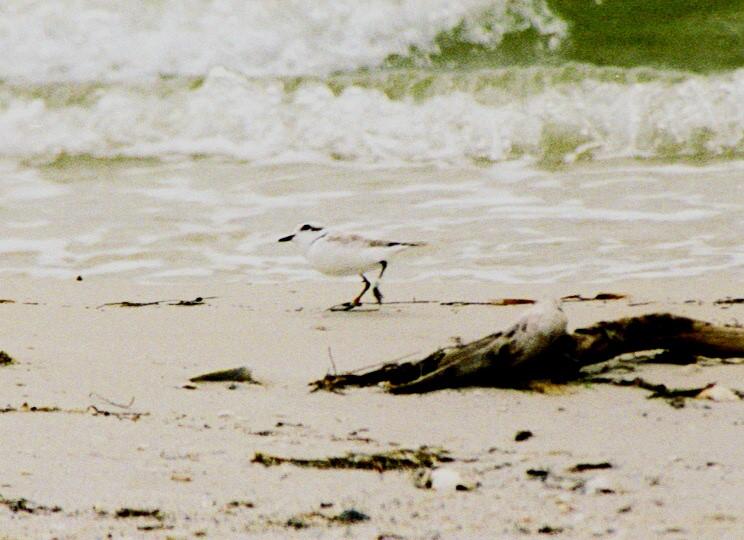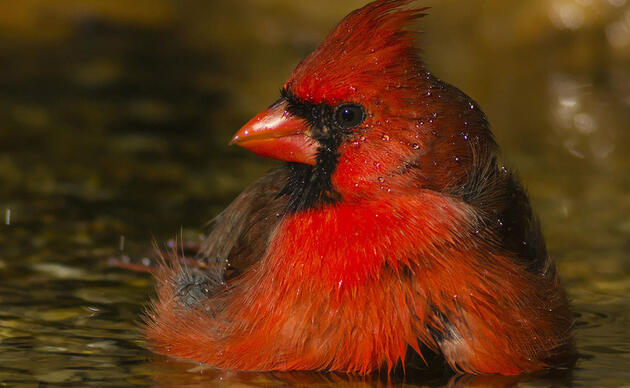
Audubon Florida's Coastal Conservation team operates throughout the state. They are - in many ways - the eyes and ears of our shores. Please take a moment to enjoy this interesting story from Audubon's Marvin Friel in the Panhandle:
Yesterday evening, just before dusk, we rushed down to Windmark Beach (a mainland beach located in Gulf County near Port. St. Joe). What we were looking for as the sun was quickly setting was a uniquely banded Snowy Plover - a Snowy Plover whose haunts and habitat are known only to Audubon's research team and a few locals like Barbara Eells, a longtime bird rehabilitator, volunteer and snowy plover enthusiast.
This prominent Snowy Plover’s “name” is his band color combination: WL:RS, or as it is stated out loud White, Lime : Red, Service. We first recognized this noteworthy male Snowy Plover in 2006 during the Florida Fish and Wildlife Conservation Commission's (FWC) state-wide Snowy Plover census. Barbara, who had monitored WL:RS the two years prior, provided us with WL:RS’s history.
Today, WL:RS is only one of three known individuals remaining from a handful of Snowy Plovers adults originally banded in 2004 by the Florida Fish and Wildlife Conservation Commission. Like him, these individual ‘Snowies’ were the first banded in Florida to study nest productivity and adult survival. Today, WL:RS is at least 12 years old! His exact age is unknown because he was originally banded as an adult.
The reason we rushed down to Windmark yesterday evening was to check on WL:RS’s recovery. Just two weeks prior, the Florida Park Service - Audubon Florida partnership team captured him at the tip of St. Joseph Peninsula State Park (SJPSP). He had a persistent but subtle leg injury that Barbara and our team had noticed at the end of the nesting season, in late July of this year. Following the end of the nesting season, we continued to monitor him, albeit infrequently, and were hopeful that he might recover without needing recapture. However, after three months, our team decided to capture him due to his persistent limping.
On November 3, while conducting our scheduled winter shorebird surveys at SJPSP, WL:RS was observed at the park still coddling his right leg. After he was captured and in hand, we discovered that WL:RS had a small piece of shell debris lodged between his service band and leg. The shell debris was causing discomfort and inflammation.
With delicate and deliberate hands, we removed the service band and dislodged the shell debris. Almost immediately, WL:RS, appeared relieved. Because he was missing one of his color bands, we wanted to confirm his identity and upon scrutiny of his metal leg band, we were able to do so by confirming the 9 digit code engraved on his aluminum Federal Service band.
Recognizing that he would likely recover from his injury, we replaced his missing lime band with a green band and replaced his old faded service band (now difficult to read) with a new one. To allow the injured leg to heal without further harm, we changed the location of his bands to the upper right leg instead of the lower right leg. All this was to ensure recovery of the leg in the short-term, but in the long-term it would allow researchers and volunteers like Barbara to continue monitoring him in the years to come.
Running out to see WL:RS yesterday evening before the sunset was much more than a crazy birder’s bizarre compulsion and obsession. For over 10 years, the life of WL:RS paralleled our careers as researchers and how we evolved as scientists grappling with difficult questions in hopes of improving the Snowy Plover’s population in Florida. As our monitoring program grew at the Florida State Parks in the Panhandle, as more and more beachgoers visited the Florida Gulf Coast beaches, as the need for public awareness and participation in conservation increased, what we realized is that WL:RS has already persevered and transcended many of the aforementioned obstacles.
Despite weather events, tropical storms, increases in recreational pressures and the numerous native and non-native predators present on our beaches (such as coyotes, ghost crabs, raccoons, fish crows or gulls), WL:RS is still cruising the shoreline looking for that next mouthwatering amphipod. Of herculean note, the extensive data collected on WL:RS has demonstrated that he has produced at least four generations of Snowy Plovers that span the panhandle beaches from SJPSP to Tyndall Air Force Base (an FWC Critical Wildlife Area) to Dog Island (land managed by The Nature Conservancy). Remarkably, one of the chicks he fathered holds the winter migration record, for plovers banded in the Florida panhandle; wintering down at Marco Island, Florida.
So yesterday evening was a success story! Hopefully WL:RS, (now White Green: Red Service on upper leg) will continue to inspire all of the beach-nesting monitoring efforts. Snowy Plovers like WL:RS are the true Florida beach bum, they are here to be enjoyed and respected as a Florida native to our coastal beaches, like sea turtles and beach mice. Each individually banded plover has a unique story to share that ultimately shows their biological resilience in their native habitat.
We hope that birds like WL:RS will persist at coastal beaches in Florida such as Windmark Beach or St. Joseph Peninsula State Park for future generations to enjoy.
By Jonathan Webber
Stay in Touch!
Show your love of birds today. Subscribe to receive email updates about Audubon's conservation work and hear about opportunities to help birds in your area or nationwide.
Popular Stories
- Julie Wraithmell Winter Naturalist Letter, 2024
- State Developing Ambitious Game Plan for Southwest Florida Watershed Restoration, with Corkscrew Swamp Sanctuary at Its Heart
- Carol Timmis Winter Naturalist Letter, 2024
- Audubon Promotes Wetland Restoration to Help Communities Address Flooding
- Beach-nesting and Wading Birds, Facing Predation and Hurricanes, Successfully Fledge Chicks




